Salvador de Bahía is a special place, where Western culture merges with African culture to foster a unique cultural and religious syncretism. But its suburbs are also very fragile and dangerous places, where violence and crime are the paradigm that people deal with on a daily basis. The convent is located in this context, in the São Cristóvão neighborhood, one of the poorest and most dangerous in Salvador. Here, good architecture can be an antidote to the marginality to which millions of people are condemned in the suburbs around the world. It is a sign of respect and dignity."
Between the sacristy and the administration buildings to the northeast is the library, a translucent polycarbonate volume suspended on four cumaru wood pillars that at night becomes a luminous lantern. To the southeast is the building that houses the cells of the monks and nuns, the only 3-story building that consists of a precast concrete structure. The complex is surrounded by a wooden exoskeleton that houses the distribution gallery and the wooden sunshade systems necessary to prevent overheating of the walls and guarantee protection from rainwater.
Being a religious building, it was clear that it also had to embody symbolic values for all the faithful who would attend it, a community in constant growth, accustomed to living in a highly degraded and often marginalized context. A special building that is familiar at the same time. A safe place to call home.
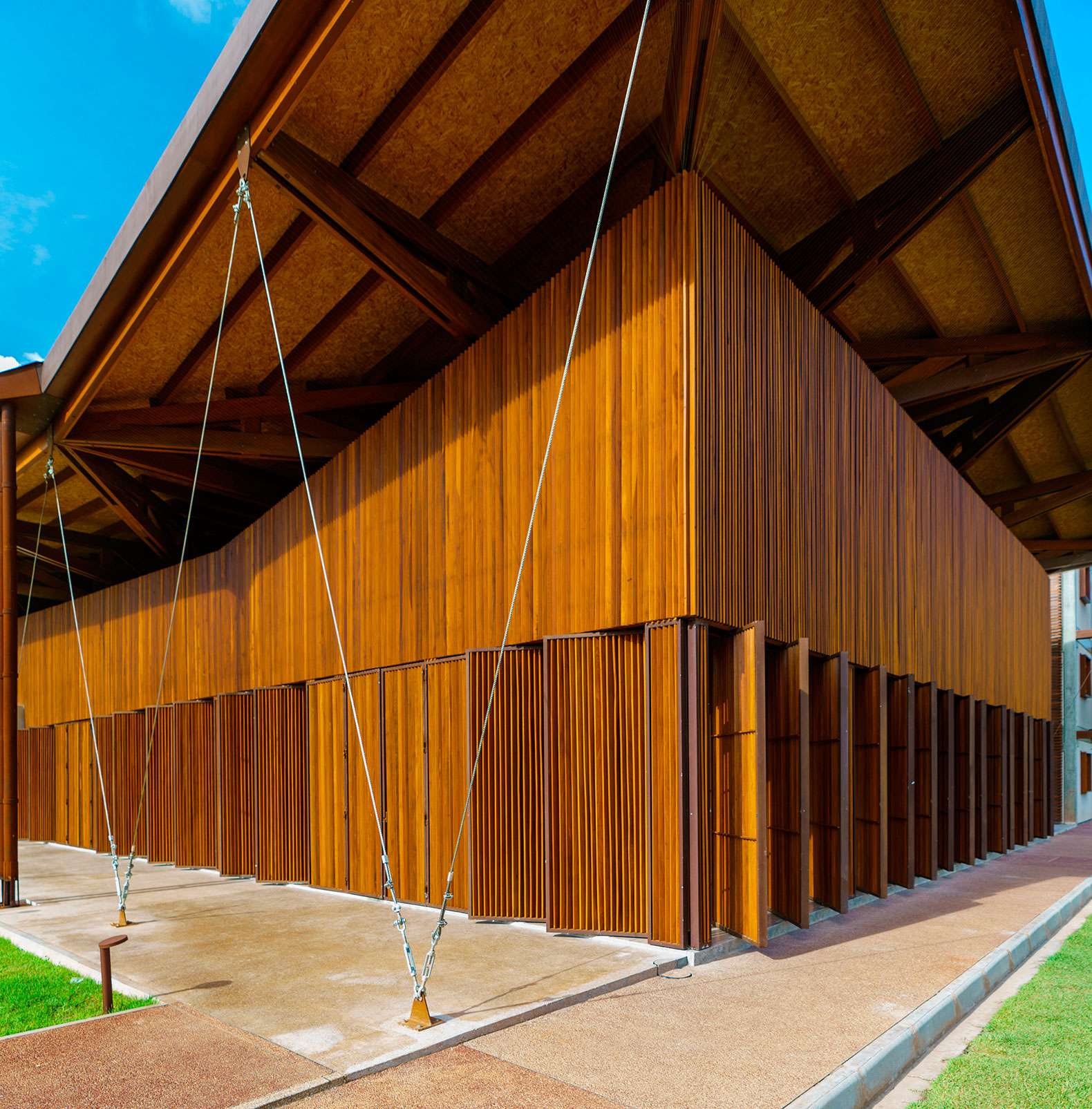
Convent of the Franciscan Fraternity of Bethany by Mixtura. Photograph by Cesare Querci.
It is comprised of low-tech buildings, where wood textures design the structure and cladding, giving the building a strong architectural identity that is further enhanced from the use of local artisanal manpower and traditional cooling techniques.
Large wooden roofs and "brise-soleil" protect the buildings from direct solar radiation, while permeable walls and rotating adjustable panels keep the rooms naturally ventilated, resulting in environmentally-friendly comfort without the use of mechanical systems.
The complex was designed to combine maximum energy efficiency with minimum environmental impact, aided in large part by the use of photovoltaic panels and rainwater recovery systems.
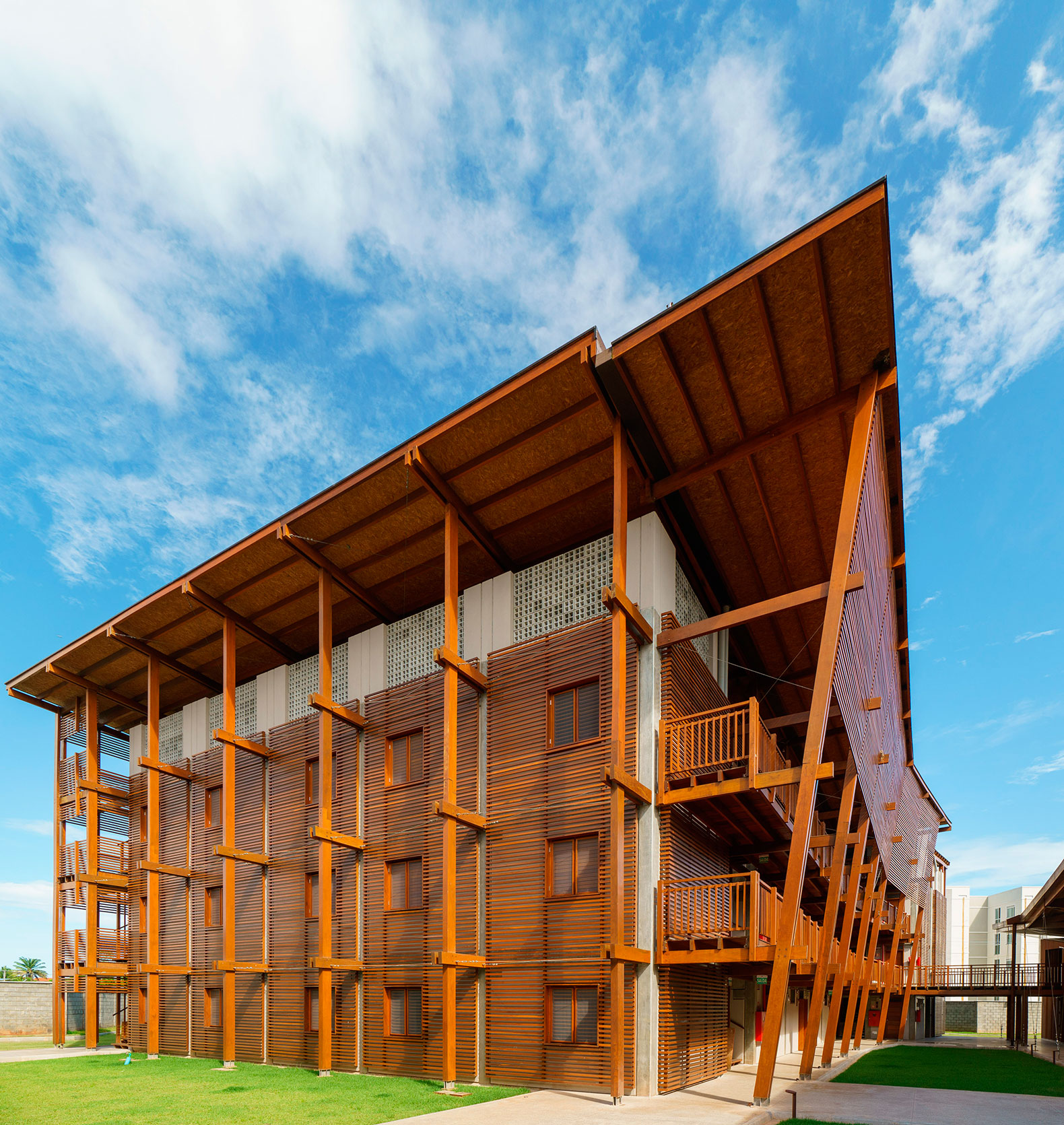
Convent of the Franciscan Fraternity of Bethany by Mixtura. Photograph by Cesare Querci.
Description of project by Mixtura
1 Premise
The design of the new Convent of the Franciscan Fraternity of Bethany in Salvador de Bahia has involved us professionally and humanly for many years. It was not only about designing a convent as a building, but also of deeply understanding the nature of the place where we would go to design. Salvador de Bahia is a special place, where Western culture merges with the African one, translating into a very unique cultural and religious syncretism.
What strikes you about Salvador is the smile of the peoples, the generous nature and the tropical climate, but also the jarring danger of its fragile suburbs, contexts that are difficult to frame in a unique way, where violence and crime are the paradigm with which people are used to dealing every day.
The Convent is located in this context, in the São Cristóvão district, one of the poorest and most dangerous in Salvador, where each new architecture can be an opportunity for social redemption.
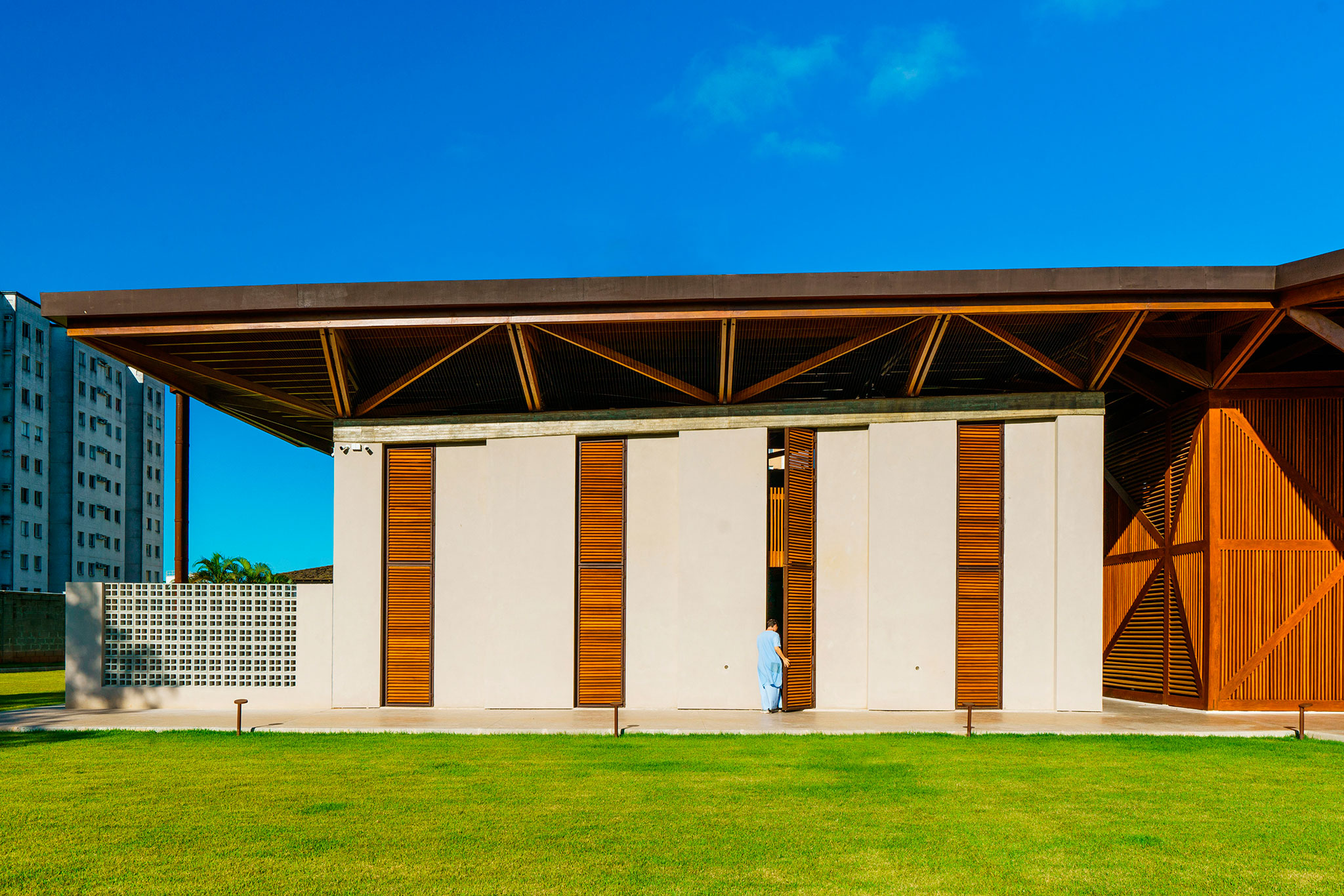
Convent of the Franciscan Fraternity of Bethany by Mixtura. Photograph by Cesare Querci.
Whether it's a church, a square, a school or, as in this case, a convent, architecture can be an antidote to the marginalization to which millions of people are condemned in many suburbs of the world. A sign of respect and dignity.
We wanted to create a special building but at the same time "easy to understand". A hospitable and safe place to call home, which represented the nature of the clients, religious dedicated to prayer but also to hospitality and moments of celebration and sharing typical of the Franciscan and Marian charism that distinguishes them.
Thus, like a large tree offering shade and shelter to the traveler from the sun and rain, the New Convent will welcome the local community by offering a place of suspension of conventional time and space.
2 "Il complesso conventuale"
2.1 The context
The Convent is situated in the neighborhood of São Cristóvão, one of the most dangerous and fragile of Salvador.
The Franciscan Fraternity of Bethany is there since 2010, albeit in a temporary structure, and in 2012 it created a kindergarten for more than 100 children from the neighboring favelas, as part of a wider social project that after the completion of the convent will see the realization of a school.
The importance of creating a convent building in an area like this goes beyond its purely spiritual function: it means creating a safe meeting place for a very large community.
2.2 The functional program
The design of the new convent took place through a long-time participatory process which allowed us to focus on a complex functional program that combined the requests related to the lifestyle of the clients, religious dedicated to prayer, hospitality and to fraternal life, with the needs deriving from the climatic and social conditions of the site.
The design took place partly in Italy and partly in Brazil, to fully understand the spirituality of the client and the meaning of creating a convent in such a particular context.
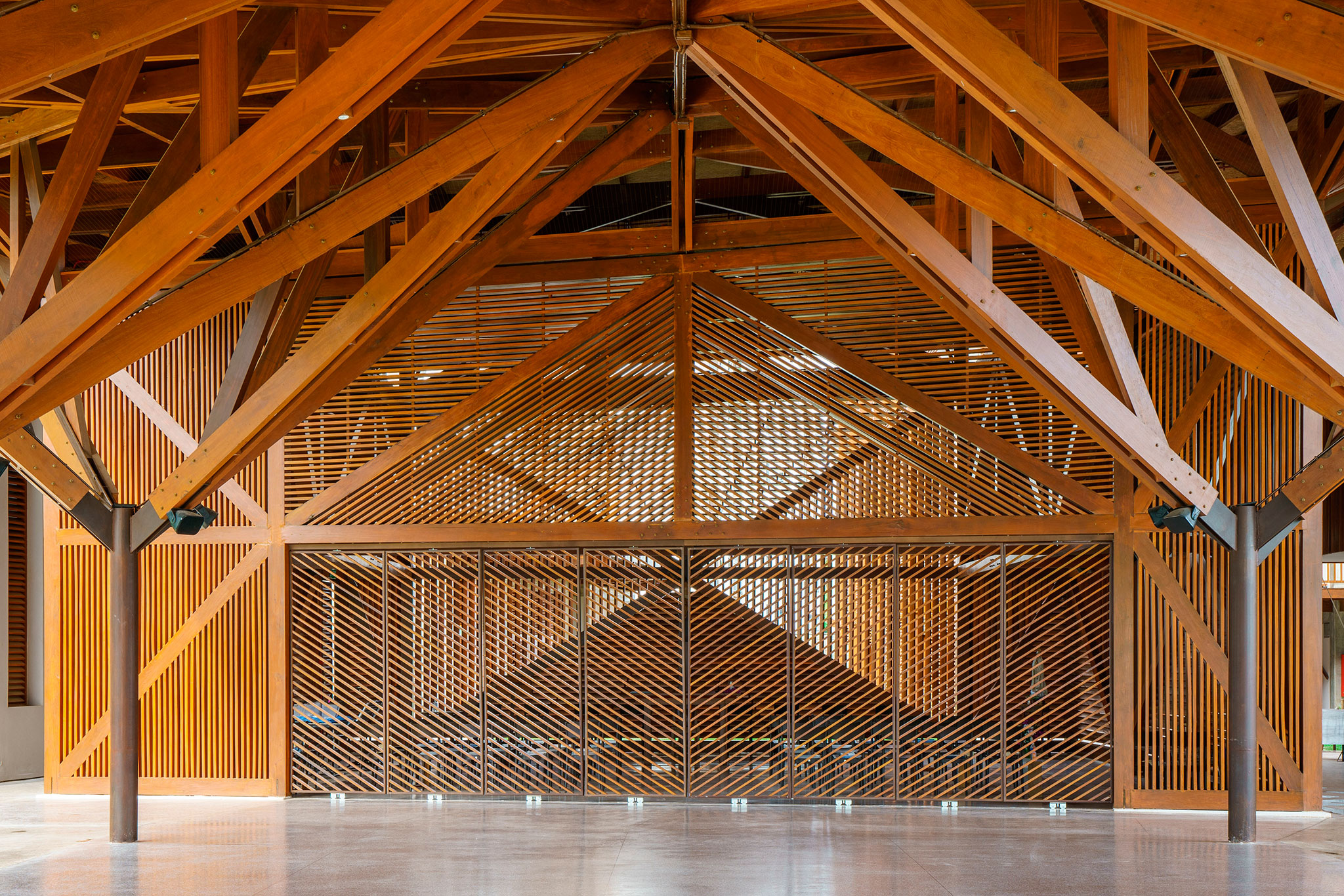
Convent of the Franciscan Fraternity of Bethany by Mixtura. Photograph by Cesare Querci.
Living the life of the convent we understood how important it was to organize the spaces around the rules that mark the day, rules made up of individual moments of prayer and moments of sharing, but as the same time how the often-extreme conditions of the subtropical climate, influence the lifestyle.
Since the building would not have had mechanical air conditioning systems, it was necessary to offer protection from the sun and shelter from the rain but at the same time leave the air to flow between the buildings.
Since it was a religious building, it was clear that it should also embody symbolic values for all the faithful who would frequent it, a constantly growing community, accustomed to living in a highly degraded and often marginalized context. A special building that is familiar at the same time. A safe place to call home.
2.3 The planimetric concept
Planimetrically, we reinterpreted the classical introverted conventual typology multiplying the number of cloisters and thinning out the buildings to allow the wind, which constantly blows from the east, to reach all the buildings and open areas. The convent's morphology is articulated around five green cloisters: at west, facing the access door and the main municipal road, there is the public part of the complex, dedicated to welcoming, with the refectory at south, the church in the middle and the sacristy and reception hall at north. These buildings, although autonomous and recognizable, are ideally and formally united by a large wooden roof which gives them architectural unity. In front of the chapel, in continuity with the large roof, there is a covered square, a meeting place that offers shelter from the sun during the day and allows the church to accommodate more than 500 seated people. Between the sacristy and the administration buildings to the northeast stands the library, a translucent polycarbonate’s volume suspended on four cumaru’s wood pillars that at night becomes a luminous lantern that allows its contents to be perceived. To the south-east is the building that houses the cells of the monks and nuns, the only 3-floor building consisting of a precast concrete structure, a very widespread and reliable technology in Salvador. It's surrounded by a wooden exoskeleton that houses the distribution gallery and systems of wooden brise-soleil necessary to avoid overheating of the walls and to guarantee shelter from rainwater.
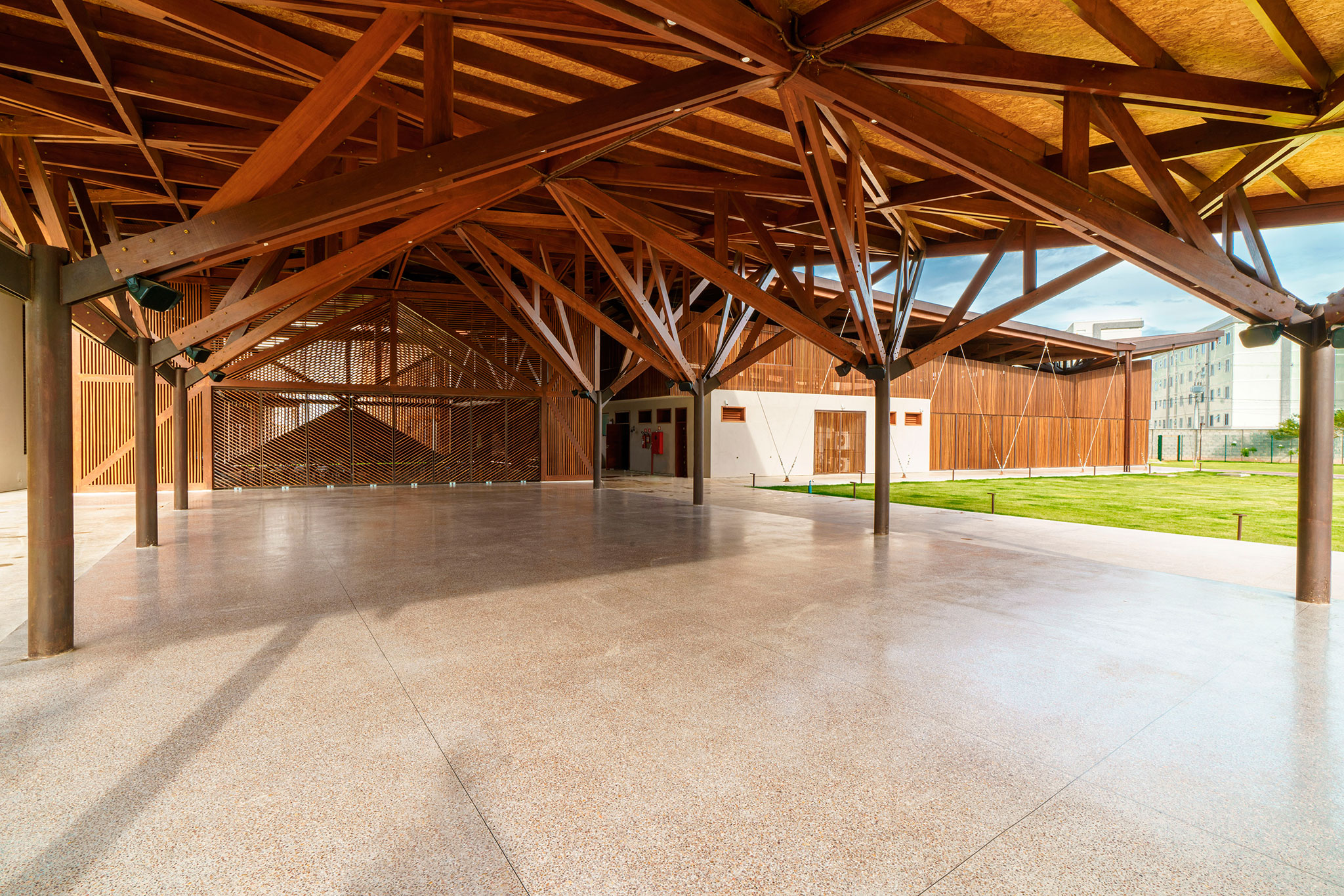
Convent of the Franciscan Fraternity of Bethany by Mixtura. Photograph by Cesare Querci.
2.4. Bioclimatic strategies
The complex, which has no mechanical ventilation systems, seeks to enhance the climatic peculiarities of the context. From the ocean, to the east, a constant breeze blows, therefore, the building was fragmented to allow the wind to circulate within the complex, in a succession of spatial compressions and decompressions. Each building adopts low-tech bioclimatic strategies according to the function it hosts. To the west, where the buildings with the greatest number of visitors are located, the envelopes are permeable to the wind, with "brise soleils" and movable panels to regulate the flow of air. This is the case in the refectory and in the church, where the brise-soleils have the dual function of filtering the light and preventing overheating.
The reception hall and sacristy building to the north-west, on the other hand, has a more closed building envelope to guarantee the right privacy and security for the functions it hosts. The walls are in fact in masonry, with an increased thickness to increase the thermal displacement. Here too, 4 full-height panels allow you to maximize air circulation if necessary.
All three buildings are protected by a large roof, raised above the building envelope, which favors the escape of hot air, helping to maintain environmental comfort even in the hottest periods of the year.
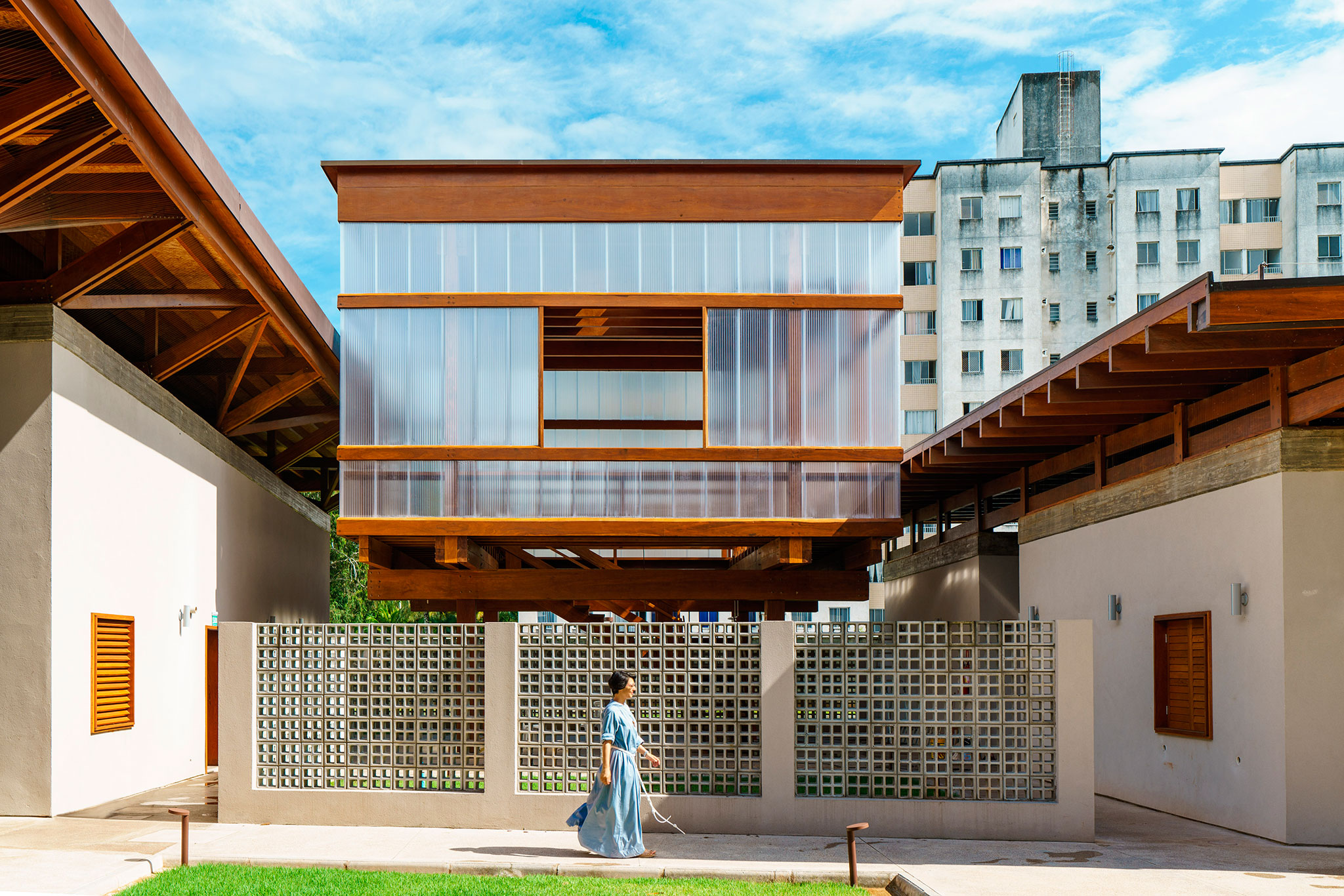
Convent of the Franciscan Fraternity of Bethany by Mixtura. Photograph by Cesare Querci.
Adjacent to the sacristy is the library, which stands out as an independent body from the rest of the building and which has a translucent polycarbonate cladding. Completely open on the ground floor, it takes advantage of the fireplace effect to cool the rooms.
To the northwest, however, the building with the chapter house, the training rooms and the workshop adopts the same strategies as the sacristy/secretary, with a raised, ventilated roof.
The accommodation building, the only one with 3 floors, has a prefabricated reinforced concrete structure surrounded by a wooden exoskeleton. Here the distribution is entrusted to external balconies, sheltered from the rain and the sun and covered with wooden brise-soleil systems. Cross ventilation is guaranteed in each cell with Venetian blind systems above the doors and windows.
The use of photovoltaic panels for the production of electricity, hot water and the recovery of rainwater make the convent complex almost completely self-sufficient from an energy point of view.
2.5 The architectural language
Climaticc strategies, symbolic values and technological needs deriving from the socio-economic context have given life to the architectural language. The planimetric fragmentatioon, obtained thanks to the insertion of the natural element of the green cloisters, recreates the urban complexity in the layout of the convent. Squares, avenues and changing and dynamic points of view follow one another in the alternation between open and closed spaces.
Each building maintains its own architectural identity, obtained through the declination of the wooden element which sometimes has a bioclimatic function, sometimes it is a structure and cladding. The different degrees of permeability of the building envelope are emphasized when the convent is illuminated, giving rise to transparencies that change depending on the position of the observer.
The binding of the various buildings is entrusted to the roofs. In the western part, a large roof protects the refectory, the church and the sacristy from the sun like a "sombrero". The same ploy is used in the building with the training rooms and the chapter house, as well as in the lodgings. The only emergence, which deliberately stands out from the rest of the building, is that of the library, a building suspended on four wooden pillars and clad in polycarbonate.
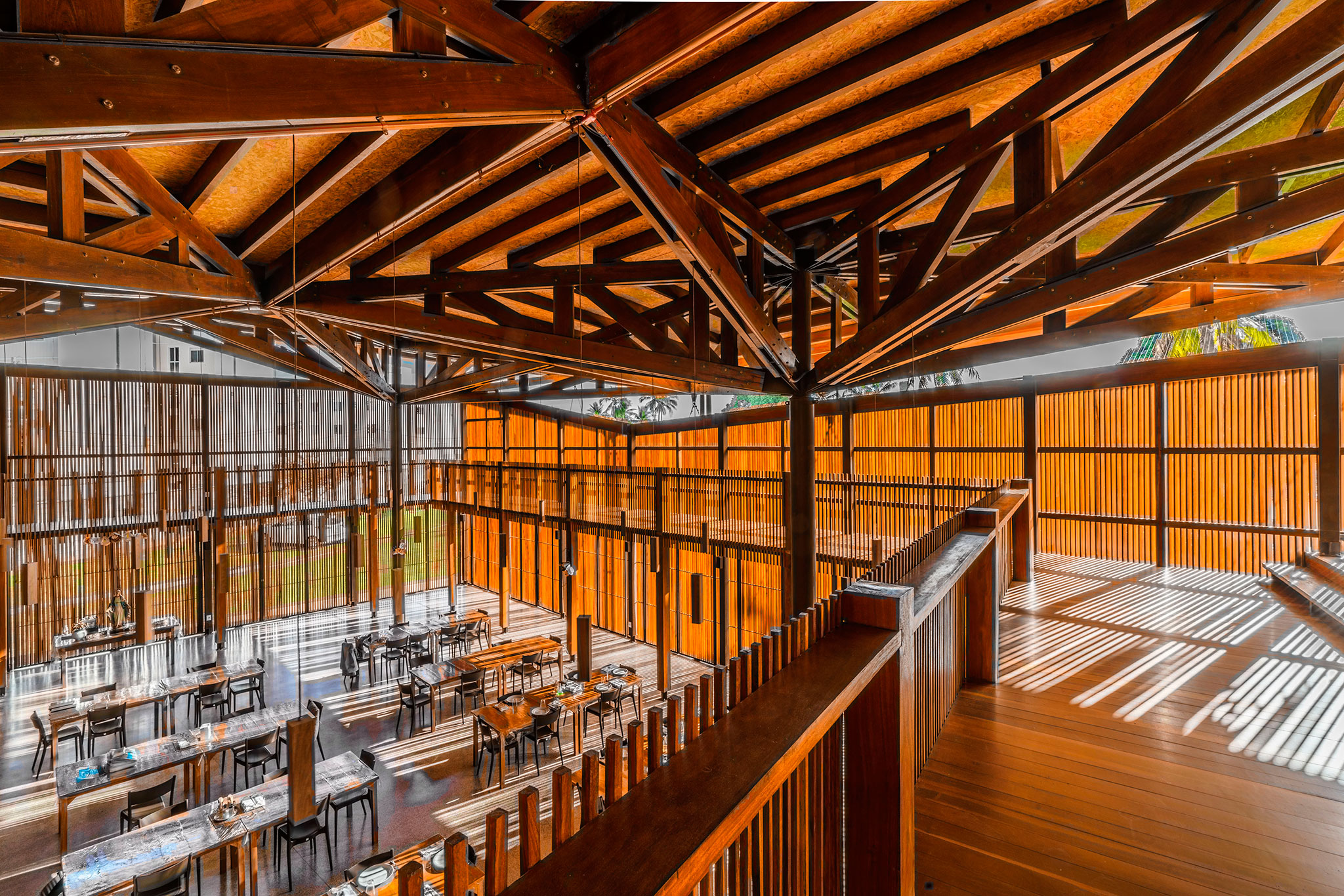
Convent of the Franciscan Fraternity of Bethany by Mixtura. Photograph by Cesare Querci.
3 "Gli edifici"
3.1 The refectory
Conviviality and hospitality are two of the peculiarities of the Franciscan Fraternity of Bethany and for this reason the refectory is one of the most representative buildings of the entire architectural complex. It is a permeable building, covered by a roof supported by six cor-ten steel pillars which make it independent from the building envelope. The latter, like a protected enclosure, is made up of wooden slatted elements and pivoting panels on the ground floor which make it fully openable and at the same time allow you to control the circulation of air inside the building.
The hall is designed as a flexible space, which can also be used for theatrical events and concerts, taking advantage of the balcony that surrounds it on the first floor as an additional space for the public. The image of the building is changeable: compact at first sight, as you get closer it lets you perceive its ethereal nature, dematerializing as the light and the position of the observer change.
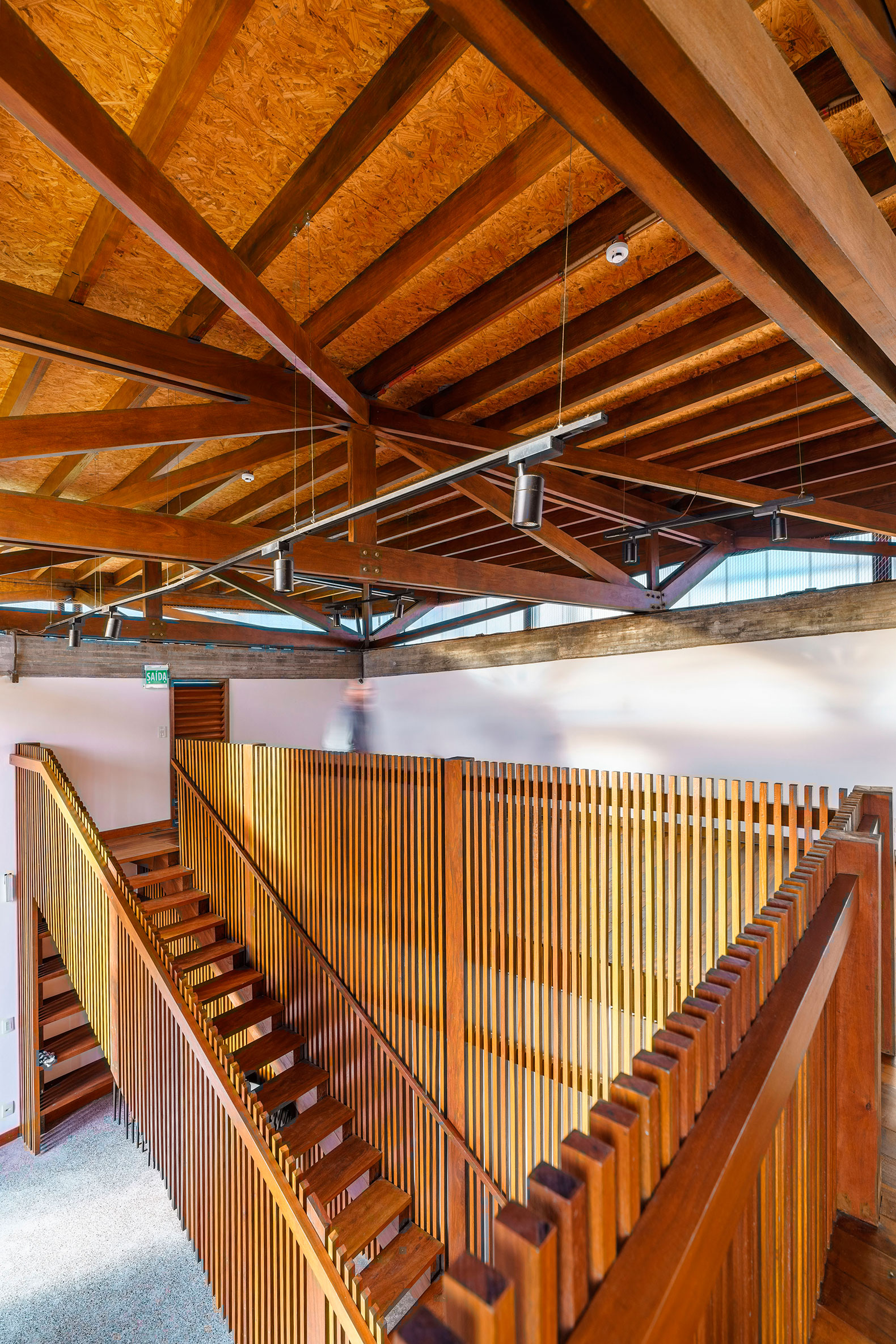
Convent of the Franciscan Fraternity of Bethany by Mixtura. Photograph by Cesare Querci.
3.2 The sacristy and reception
To the north-west is the building that houses the sacristy and the reception hall characterized by a hybrid structure in reinforced concrete and wood. To guarantee security and privacy, the building envelope is in masonry. Four full-height panels in cor-ten steel and wood that can be opened allow you to control the natural lighting and the air flow inside the building.
3.3 The church
Central element of the architectural composition of the whole convent, it is one of the two buildings together with the library entirely in wood. The building is in fact itself a structure that supports the roof. Conceived as a three-dimensional truss beam, the structure generates a natural cross on the back wall, which becomes the focal point of the whole church. The infill panels are made with brise-soleil elements which allow the passage of air inside the building and at the same time preserve its privacy. On the main façade, pivoting and sliding panels allow the church to open onto the covered square in front of it, expanding its capacity and accommodating up to 500 people.
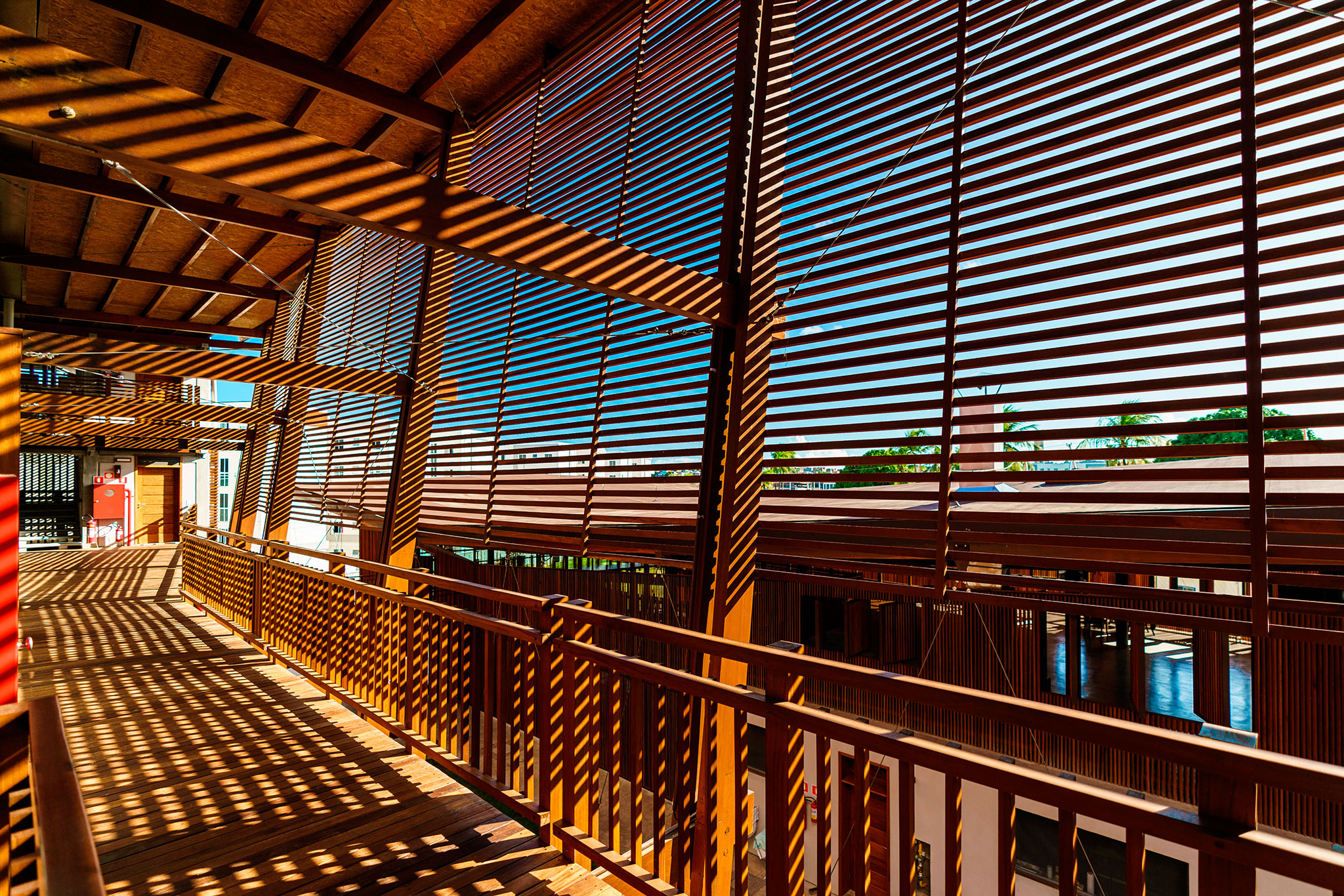
Convent of the Franciscan Fraternity of Bethany by Mixtura. Photograph by Cesare Querci.
3.4 The library
The library has an autonomous structure and conformation. Supported by four cumaru wood pillars, it is covered in polycarbonate. At night it becomes a translucent luminous lantern that allows its contents to be perceived through its transparency.
3.5 The study rooms and auditorium
To the north-east are the training rooms, the chapter house, the warehouses and the workshop. All the functions are housed in three distinct volumes made of reinforced concrete and masonry, connected by a single raised roof made of wooden reticular beams.
3.6 The cells building
The building houses the cells of the monks and the guest rooms of the fraternity. Built in prefabricated reinforced concrete elements, it is surrounded by a wooden exoskeleton that houses the balconies and shading systems. The buildings are divided to allow the wind to enter the internal courtyard and the distribution galleries. The level of the terraces is surrounded by a perimeter of "cobogo", prefabricated concrete elements, widely used in tropical climates, useful for letting the air pass but at the same time guaranteeing protection from the rain and the right amount of privacy.






























































